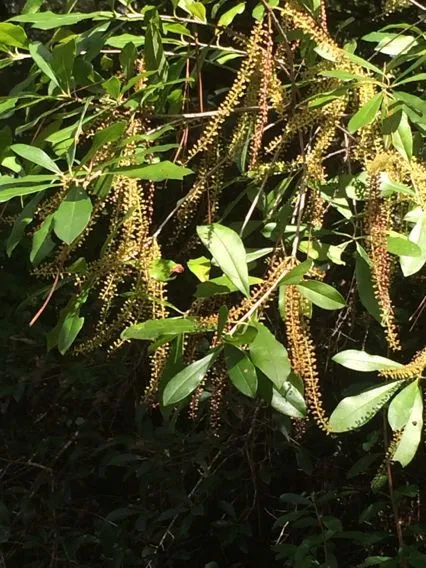
Author: L.
Bibliography: Mant. Pl. 1: 50 (1767)
Year: 1767
Status: accepted
Rank: species
Genus: Cyrilla
Vegetable: False
Observations: SE. U.S.A. to Trop. America
Black titi, known scientifically as Cyrilla racemiflora, is a noteworthy plant that holds a special position in the flora of several key regions including the southeastern United States and tropical areas of the Americas. This species was first meticulously documented by the esteemed botanist Carl Linnaeus in 1767, lending credence to its long-standing recognition and importance in botanical studies.
Belonging to the family Cyrillaceae, Black titi is characterized by its unique botanical features that make it particularly distinguishable. It serves as an essential plant within its ecosystem, contributing significantly to the biodiversity and environmental dynamics of the areas it inhabits.
The plant is a versatile and resilient species, capable of thriving in a wide range of environmental conditions found across its extensive geographical range. From the moist, humid climates of the southeastern United States to the varied tropical environments of the Americas, Cyrilla racemiflora demonstrates remarkable adaptability.
This species is often observed growing in wetlands, swamps, and other moist, lowland habitats, where it plays a crucial ecological role. The presence of Black titi in these areas supports a diverse array of wildlife, providing habitat and food for various birds, insects, and other animals. The plant’s flowers are particularly attractive to pollinators, while its seeds and foliage are utilized by various fauna for nourishment.
In addition to its ecological significance, Cyrilla racemiflora has also been of interest for various human uses. Its dense wood has been historically used in crafting and construction, while its aesthetic appeal makes it a popular choice in landscaping and ornamental gardening. The aromatic, raceme-like clusters of flowers not only add visual interest but also fill the air with a pleasant fragrance during the blooming season.
Given its rich botanical history and multi-faceted utility, Black titi remains a species of significant interest to both scientists and nature enthusiasts. Its enduring presence from southeastern North America to tropical America is a testament to its ecological importance and its adaptability to diverse environmental conditions.
Eng: black titi, he-huckleberry, ironwood, leatherwood, myrtle, red titi, swamp cyrilla, swamp titi, titi, white titi
En: Black titi, He-huckleberry, Leatherwood, Titi, White titi, Red titi, Myrtle, Ironwood, SWAMP CYRILLA, Swamp titi
© copyright of the Board of Trustees of the Royal Botanic Gardens, Kew.
© copyright of the Board of Trustees of the Royal Botanic Gardens, Kew.
Taken Oct 8, 2014 by EOL − Laura Clark (cc-by-nc)
Taken Jan 1, 1900 by EOL − Cooper, G.A. (cc-by-nc-sa)
Taken Jan 1, 1900 by EOL − Kristen Van Neste (cc-by-nc-sa)
Taken Jan 1, 1900 by EOL − Kristen Van Neste (cc-by-nc-sa)
Taken Jan 1, 1900 by EOL − Kristen Van Neste (cc-by-nc-sa)
Taken Dec 11, 2021 by Paris B (cc-by-sa)
Taken May 15, 2019 by Mary Olsen (cc-by-sa)
Taken Aug 26, 2019 by Luke Luke (cc-by-sa)
Taken Jan 1, 1900 by EOL − Howard, R.A. (cc-by-nc-sa)
Taken May 12, 2022 by Lorraine Smith (cc-by-sa)
Taken Jan 1, 1900 by EOL − Howard, R.A. (cc-by-nc-sa)
Taken Apr 21, 2020 by Luke Luke (cc-by-sa)
Taken Jan 1, 1900 by EOL − Dorr, L.J. (cc-by-nc-sa)
Taken Oct 22, 2018 by Todd Schnakenberg (cc-by-sa)
Taken May 12, 2022 by Lorraine Smith (cc-by-sa)
Taken Jun 14, 2021 by Matthew Horrigan (cc-by-sa)
Taken Oct 22, 2018 by Todd Schnakenberg (cc-by-sa)
Taken Oct 6, 2021 by John Cumper (cc-by-sa)
Taken Sep 3, 2019 by Luke Luke (cc-by-sa)
Taken Jan 1, 1900 by EOL − USDA NRCS Wetland Science Institute. (public)
Taken Jun 14, 2019 by Eli Small (cc-by-sa)
Taken Nov 23, 2022 by Eli Small (cc-by-sa)
Taken Nov 23, 2022 by Eli Small (cc-by-sa)
Taken Jun 3, 2020 by Magalhaes Lucas (cc-by-sa)
Taken Jul 13, 2020 by Chaitali Saqcena (cc-by-sa)
Growth form>: Thicket Forming
Growth habit>: Tree, Shrub
Growth rate>: Moderate
Ph maximum: 6.8
Ph minimum: 4.9
Family: Myrtaceae Author: (F.Muell.) K.D.Hill & L.A.S.Johnson Bibliography: Telopea 6: 402 (1995) Year: 1995 Status:…
Family: Rubiaceae Author: Pierre ex A.Froehner Bibliography: Notizbl. Bot. Gart. Berlin-Dahlem 1: 237 (1897) Year:…
Family: Sapindaceae Author: Koidz. Bibliography: J. Coll. Sci. Imp. Univ. Tokyo 32(1): 38 (1911) Year:…
Family: Asteraceae Author: A.Gray Bibliography: Pacif. Railr. Rep.: 107 (1857) Year: 1857 Status: accepted Rank:…
Family: Fabaceae Author: Medik. Bibliography: Vorles. Churpfälz. Phys.-Ökon. Ges. 2: 398 (1787) Year: 1787 Status:…
Family: Aspleniaceae Author: (Cav.) Alston Bibliography: Bull. Misc. Inform. Kew 1932: 309 (1932) Year: 1932…